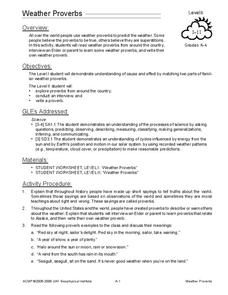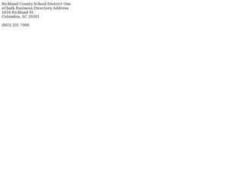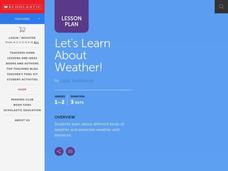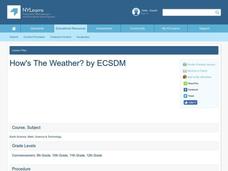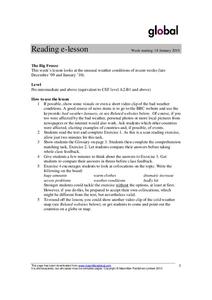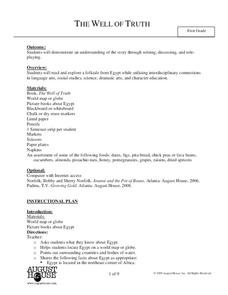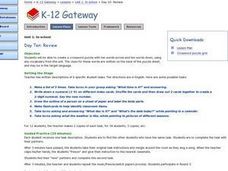Core Knowledge Foundation
Seasons and Weather: Read-Aloud Anthology
Kindergartners explore the cycle of the seasons in a 10-lesson language arts unit. Through a series of picture-supported read-aloud activities, children are able to identify the sequence of seasons and the types of weather...
NOAA
Thunderstorms, Tornadoes, Lightning. . . Nature's Most Violent Storms
Thunderstorms, tornadoes, floods, and hail are just a few of the topics covered in a thorough weather preparedness guide. With descriptions of each weather phenomenon, from what causes them to how and when they occur to...
Curated OER
Weather Proverbs
Your class explores weather proverbs and superstitions from around the country and writes their own proverb about weather. They interview community elders to learn proverbs about Alaska and its weather. Then they discuss several example...
Curated OER
Observing Weather
Students investigate the weather by reading children stories. In this weather observation lesson, students read Cloudy With a Chance of Meatballs and several other stories about weather before they create a KWL chart....
Curated OER
Let's Learn About Weather!
Students read several weather-related stories. They brainstorm weather words and use them as they make a weather booklet that includes pictures, a story of their own, and observations they make about the weather outside on that day.
Houghton Mifflin Harcourt
Smart Solutions: English Language Development Lessons (Theme 6)
Smart Solutions is the theme of a unit created to meet the needs of English language earners. Through a series of lessons, scholars follow a routine—move, speak, and listen— to cover topics including stores, shops, celebrations, pets,...
Curated OER
Stormy Weather
Fifth graders demonstrate their knowledge for how animals survive in natural environments when a storm occurs. In this science/writing lesson, 5th graders engage in a listening activity with the teacher. Additionally, students write a...
Curated OER
How's the Weather?
Students explore earth science by researching the Internet. In this weather pattern lesson, students utilize the website weather.com to analyze the weather in different geographic locations. Students view charts and graphs based on...
Curated OER
It's A Blue, Blue Monday
Students create images that convey how the weather makes them feel. As a class, students discuss the way weather can effect their mood. After reading several passages describing the weather, students use vivid descriptions and...
Curated OER
The Big Freeze
Students read to examine unusual weather conditions. For this reading comprehension lesson, students complete 4 activities, explore several websites, and read a story. Students will then answer comprehension questions.
Curated OER
Look Up!
Students investigate the sky. In this weather and clouds lesson, students observe the sky and write journal entries using their five senses to describe what they see. Students observe, identify, and write about the different...
Curated OER
Clouds
In this clouds instructional activity, students respond to 3 different sets of questions related to the 3 types of clouds illustrated. First, they label each type of cloud illustrated in the pictures. Then, students draw a line from each...
Curated OER
Comprehension: Answering Questions then Rereading the Text to Identify Details in Support of the Answers
Even first graders can be exposed to good reading strategies and comprehension skills. The teacher demonstrates how to read informational text, look at the questions, reread the text, locate answer, then locate supporting details to...
K12 Reader
What's the Forecast?
Rain gauges, thermometers, and wind vanes. After reading a short article about weather forecasting, readers identify the tools meteorologists use to predict the weather.
Curated OER
Clouds
Second graders explain what a cloud is, how it is formed and what the various types of clouds are. They do an experiment which shows them how to "make" a cloud, and write in their science journals about a "crazy weather day."
Curated OER
Rain
First graders practice oral and silent reading using beginning comprehension and decoding strategies. In this guided reading lesson, 1st graders take a picture walk and make plot predictions prior to reading the book Rain by Robert...
Curated OER
Pollution in the Air and the Water Pollution Solution
Students explore air pollution. In this ecology and air pollution lesson, students perform an experiment in which a Vaseline coated lid is placed inside and outside the classroom. Students make predictions and then record what they see...
Curated OER
Poetry Reading
Students express the ideas of a poem. In this poem dramatization lesson, students analyze poems for meaning studying their descriptive words. Students role play the descriptive language of the poem. Students draw a picture of the...
Soft Schools
Metaphors: Understanding Comparisons
Here's a metaphor worksheet that asks kids to identify the two things being compared and then to explain the similar characteristics that are being identified.
Curated OER
The Well of Truth
Students read and explore an Egyptian folktale. In this folktale lesson, students read the book The Well of Truth and discuss geographical facts about Egypt. Students complete several reading comprehension activities including a...
Curated OER
Crossword Review
Students practice using their target language vocabulary by completing a crossword puzzle. In this foreign language lesson plan, students complete several random tasks based on new vocabulary words in their target language dealing...
Curated OER
Why Predict?
Twelfth graders examine the process of predicting. They observe a fine art transparency, discuss their predictions about the artwork, identify the types of predictions made during a weather broadcast, and evaluate headlines from...
Curated OER
Literature-based Skill Building: Holes by Louis Sachar
In this reading skills worksheet, students complete several literature-based skill building activities for the book 'Holes' by Louis Sachar.
Curated OER
Water 1: Water and Ice
Students examine the changes as water goes from solid to liquid. In this states of matter lesson, students observe and record the changes to water as it changes from solid to liquid and back to solid.


